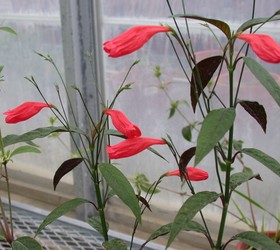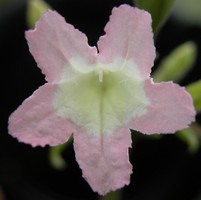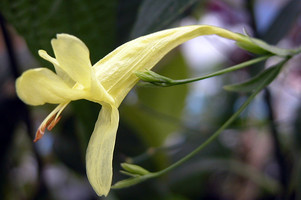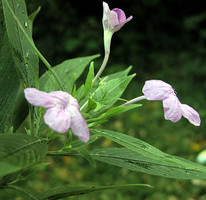Physiruellia clade
Erin Tripp- Ruellia amplexicaulis (Nees) Lindau
- Ruellia angustiflora (Nees) Lindau
- Ruellia biolleyi Lindau
- Ruellia breedlovei T. F. Daniel
- Ruellia brevifolia (Pohl) C. Ezcurra
- Ruellia chartacea (T. Anders.) Wassh.
- Ruellia costata (Nees) Lindau
- Ruellia eumorphantha Lindau
- Ruellia fulgens (Bremek.) E. Tripp (= Polylychnis fulgens Bremek.)
- Ruellia fulgida Andr.
- Ruellia gracilis Rusby
- Ruellia grantii Leonard
- Ruellia haenkeana (Nees) Wassh.
- Ruellia ischnopoda Leonard
- Ruellia jussieuoides Schltdl. & Cham.
- Ruellia longipedunculata Lindau
- Ruellia macrophylla Vahl var. lutea Leonard
- Ruellia matudae Leonard
- Ruellia menthoides Leonard
- Ruellia nitida (Nees) Wassh. & J.R.I. Wood
- Ruellia oaxacana Leonard
- Ruellia pearcei Rusby
- Ruellia pedunculosa (Nees) Lindau
- Ruellia pennellii Leonard
- Ruellia proxima Lindau
- Ruellia puri (Nees) Mart. ex Jackson
- Ruellia pygmea Donn. Sm.
- Ruellia riopalenquensis Wassh.
- Ruellia rubra Aubl.
- Ruellia ruiziana (Nees) Lindau
- Ruellia sanguiea Griseb.
- Ruellia saulensis Wassh.
- Ruellia stemonacanthoides (Oerst.) Hemsl.
- Ruellia terminale (Nees) Wassh.
Note: this taxon list is still under construction. It does not yet contain all known Physiruellia clade subgroups.
Only species that were sampled in Tripp's study (in press) are listed.Introduction
The Physiruellia clade is a large group characterized by plants with dichasial inflorescences that are often profusely branched and long-pedunculate (see photo below). Species in this clade have fruits that are clavate in shape and seeds with hygroscopic trichomes restricted to the margins (vs. the symplesiomorphic state of covering the entire surface... see Euruellia). Fruits generally contain betwen 8 and 14 ovules.


Inflorescences of Ruellia brevifolia. ©
The group is particularly diverse in tropical and subtropical regions of western South America, and also occurs in tropical Mexico and Central to N. South America. Most species occupy forest understory environments. Floral morphology is diverse in Physiruellia, with several beautiful, red-flowered taxa likely great candidates for the horticultural industry (gardeners and growers take note!). Some are already in cultivation. Unlike other clades in Ruellia (see Euruellia), purple-flowered taxa are in the minority.
Polylychnis is a monotypic genus endemic to the Guiana Shield. Results from Tripp (in press) place the genus as highly nested within Ruellia. Morphologically, it is very similar to Ruellia, and indeed shares a similar pollen sculpturing. It differs perhaps only by having small projections on the nectary that surrounds the ovary base. However, Ruellia ovaries have never been systematically surveyed to an extent that permits a thorough examination of this potential difference. Based on molecular data and morphological similarity, the new combination Ruellia fulgens (Bremek.) E. Tripp was recently made.


Flowers of Ruellia fulgens (Bremek.) E. Tripp (= Polylychnis fulgens Bremek.) © 1999 Carol Gracie
Flowers of Ruellia fulgens are long-tubed and red, and are visited by hummingbirds (Gracie 1991). During anthesis, copious, dilute nectar is secreted from the annular ovary disc (11-24 % sugar concentration, >10 µL). After corollas fall, these discs continue secreting nectar, to which ants are attracted and which they consume. However, post-floral nectar is substantially higher in sugar content, ranging from 41-51 %. These ants may serve to guard and protect young, developing fruits.
References
Ezcurra, C. Systematics of Ruellia (Acanthaceae) in southern South America. Annals of the Missouri Botanical Garden 80:787-845.
Gracie, C. 1991. Observation of dual function of nectaries in Ruellia radicans (Nees) Lindau (Acanthaceae). Bull. Torr. Bot. Club. 188(2): 188-190.
Tripp, E. A. Evolutionary relationships within the species-rich genus Ruellia (Acanthaceae). Systematic Botany, in press.
Title Illustrations

About This Page

Rancho Santa Ana Botanic Garden
Correspondence regarding this page should be directed to Erin Tripp at
Page copyright © 2006
All Rights Reserved.
- First online 13 November 2006
- Content changed 10 April 2007
Citing this page:
Tripp, Erin. 2007. Physiruellia clade. Version 10 April 2007 (under construction). http://tolweb.org/Physiruellia_clade/65582/2007.04.10 in The Tree of Life Web Project, http://tolweb.org/












 Go to quick links
Go to quick search
Go to navigation for this section of the ToL site
Go to detailed links for the ToL site
Go to quick links
Go to quick search
Go to navigation for this section of the ToL site
Go to detailed links for the ToL site